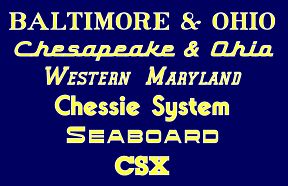== B&O Photo Tours - Guest Author ==

|
B&O-C&O-CHESSIE-CSX CORPORATE RELATIONSHIP NOMENCLATURE by HH Harwood, Jr. | |
|---|---|---|
|
|
All too often one sees references to the "merger" of the Chesapeake & Ohio and
Baltimore & Ohio railroads. In actual fact, however, there was no C&O-B&O merger,
or at least not when the writers thought so. It is also common to read about the
Chessie System as the formal name of a railroad. It never was. Similarly, while the
name "CSX" appeared in 1980, it didn't identify a railroad until six years afterward,
and even then legal identification required a qualifier in its corporate title.
The description below attempts to straighten out some of the misconceptions
associated with the C&O-B&O-CSX relationship that have taken hold and endured to
the point where they threaten to become part of recorded history. True, some of
this seems like legalistic nitpicking, but is important for the historical record.
Lacking any unified corporate name or symbol, the rather awkward and uninspiring term "C&O/B&O" became the default method of identifying the relationship, both externally and internally. That situation prevailed until the "Chessie" name and logo was adopted in 1973 as a substitute - see below. Since there was no corporate merger, the public relations people referred to the relationship as an "affiliation," a vague term that avoided directly saying "C&O control" - which could have employee morale consequences. This policy of maintaining separate corporations was, in part, the result of an Interstate Commerce Commission ruling requiring retention of an exclusively B&O sales force for several years after C&O control became effective - a concession intended to preserve solicitation of some competitive freight routes. But there were at least two compelling financial reasons: First, under its original charter, B&O was exempted from Maryland property taxes, a provision effective only as long as it retained its corporate title. Second, B&O carried a heavy debt load, which C&O feared would affect its credit standing if it were absorbed. Chessie System: There was never an operating railroad called the Chessie System. This was a marketing name and associated logo intended to serve as the public face of the "affiliated" C&O, B&O, and Western Maryland, replacing "C&O/B&O" terminology mentioned above. The name derived from Chessie System, Inc., which was created in 1973 as a non-operating holding company designed to control the C&O, B&O, and Western Maryland railroad companies. These remained legally separate corporate entities as explained above, but informally were referred to as the "Chessie System Railroads." Similarly, both employees and outsiders regularly then referred to the railroads together as "Chessie," as verbal shorthand for this complex corporate structure. (Western Maryland disappeared as a "Chessie" component when it was formally merged into B&O May 1, 1983.) CSX: CSX was not originally an operating railroad name, and did not become one until 1986. The CSX name first appeared in 1980 with the creation of CSX Corporation, a non-operating holding company, legally similar to Chessie System, Inc. In this case, CSX Corporation controlled two informal large regional railroad systems - the "Chessie System" lines in the North (C&O, B&O, WM), and the so-called "Family Lines" system in the South (Seaboard Coast Line, L&N, Georgia RR, Clinchfield, & seven others). (The latter group was controlled by another holding company, Seaboard Coast Line Industries.) Initially, the various companies constituting both the "Chessie" and "Family Lines" systems remained as corporately separate entities. Equipment continued to be lettered for their individual owners, but if repainted, carried the CSX logo with owner's initials as sublettering (see B&O 6188 at left). The creation of CSX as the formal identity applied to a railroad was accomplished through a series of mergers carried out serially between 1983 and 1987. This lengthy process was necessary because of the multiplicity of separate entities involved, each with its own corporate and financial structures. As a first step, nine of the ten separate railroad companies constituting the "Family Lines" were brought together between January 1, 1983 and June 1986 under the name of the Seaboard System Railroad. The Seaboard System R.R. was then renamed CSX Transportation as a CSX Corporation subsidiary on July 1, 1986. This became the first use of "CSX" as the name of an operating railroad. The "Chessie System" railroads followed in 1987, with B&O merged into C&O on April 30, and then C&O into CSX Transportation on August 31. Thus it was not until August 31, 1987, that the former B&O and C&O properties formally carried the CSX name - although it is important to stress that the full proper name is CSX Transportation, or CSXT. As of 2024, CSX Corporation continues in business as a holding company, with CSX Transportation as its principal subsidiary company. -HH Harwood, Jr. | |
C&O 4085 and B&O 7597 photos courtesy B&O History Collection,
B&O 4226 courtesy JD Hiteshew,
B&O 3841 and B&O 6188 courtesy HH Harwood collection
See the paint schemes evolve via more photos of B&O through CSX liveries
Trains Magazine's CSX Family Tree
Would you like your railroad essay published? Email your pitch to Steve